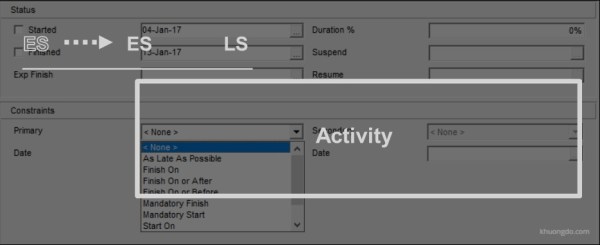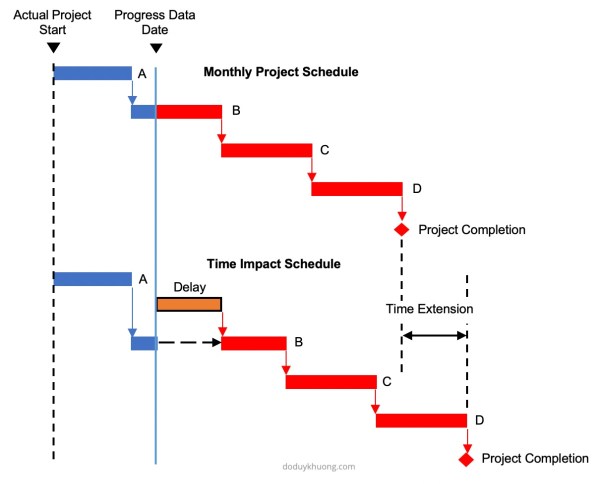Primavera P6 allows users to display multiple projects in the activity window. In this example, the Office Building is broken down into multiple projects and EPS named Office Building is opened. However, with the default group setting, the title "Office Building" is not displayed on the top. To display the title "Office Building" on the... Continue Reading →
Primavera P6: Summarize/Roll up activity duration at WBS level using duration value, not earliest and latest date
By default, Primavera P6 summarizes/rolls up activity duration at the WBS level by calculating the period from the earliest Start Date to the latest Finish Date of all activities in that WBS. In case we want to calculate the summary duration by simply adding up the duration of all activities, below are the steps. Go... Continue Reading →
Summarizing overall project schedule in 1 page by Microsoft Visio Professional
Recently, I find out a very useful tool to create a summary schedule, graphic report of a project in a Timeline or Bar chart format. That is Microsoft Visio Professional. The nice thing is that it's cheaper than Office Timeline which I've used for a few years. You can easily find a sale-off price at... Continue Reading →
Primavera P6: Cannot change Remaining Duration of an Activity
Problem When we change the Remaining duration of an activity, it keeps reverting to the original value. Change the Remaining Duration value of an activity Reason & Solution There could be two reasons of this problem: 1. There is an "Expected Finish" constraint on the activity. When using an Expected Finish constraint, the remaining duration... Continue Reading →
Primavera P6 XER Import is slow / hanged when importing Risk Category and How to avoid this
When importing an Primavera P6 XER file, P6 Professional could be very slow or hanged when it starts to import Risk Category like the picture below. Primavera P6 Import with Risk Category These Risk Category comes from a Primavera model or database that use Risk Analysis application. If we do not use this Risk Analysis... Continue Reading →
Primavera P6 Constraint: How does it work?
1. Purpose of Constraints in Primavera P6 Date restrictions used to reflect project requirements that cannot be built into the network logic.More accurately reflect real-world aspects of a project.Provide added control of a project.Apply to the entire project or to individual activities.Commonly used project-level constraint: Must Finish ByCommonly used activity-level constraint: Start On or AfterNo... Continue Reading →
Delay Start-up Insurance to cover Anticipated Profit, Revenue in a Delayed Project
1. What is Delay Start-up Insurance (DSU)? Delay in start-up (DSU) cover is designed to secure the portion of revenue which the owner: Requires to service debt; and Realize anticipated profit. It provides protection against delays arising from physical damage caused by any type of peril included in the relevant material damage cover, i.e. the... Continue Reading →
Basic Concepts and Principles of Construction Claims
1. Introduction 1.1. Construction Claims What is Construction Claims? A construction claim is the assertion of a right demanding either additional time or/and payment due to the result of an action. It is possible to meet construction claims in all construction projects. Why do Construction Claims occur? Clients, contractors, and subcontractors of this environment try... Continue Reading →
Concurrent Delay and Pacing Delay in Construction Claims
What is Concurrent Delay in Construction Claims? Meaning of concurrent delay (from SCL Delay and Disruption Protocol 2nd Edition) True concurrent delay is the occurrence of two or more delay events at the same time, one an Employer Risk Event, the other a Contractor Risk Event, and the effects of which are felt at the... Continue Reading →
Typical Delay Analysis Methods in Construction Claims
This article addresses the concepts of several typical delay analysis methods in construction claims. Why do we need Delay Analysis in Construction Claims? Because The Delay Must Affect The Critical Path The Construction Contracts often state that no adjustment to the critical milestones dates or the scheduled completion dates would be made unless the delay... Continue Reading →
How does Primavera P6 determine a driving relationship between activities?
The Driving Relationship is determined based on the Relationship Free Float and the business rules for Driving Relationships. Relationship Free Float Relationship Free Float (Rel FF): The Free Float on the relationship. Calculated as Successor Early Start (assuming a Finish to Start relationship) - Relationship Early Finish on the predecessors' calendar. This field is computed... Continue Reading →













You must be logged in to post a comment.